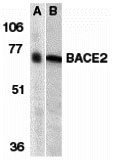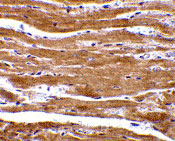BACE2 Antibody
- 产品详情
- 实验流程
- 背景知识
Application
| WB, E, IHC-P |
|---|---|
| Primary Accession | Q9Y5Z0 |
| Other Accession | AAF17078, 6561812 |
| Reactivity | Human, Mouse, Rat |
| Host | Rabbit |
| Clonality | Polyclonal |
| Isotype | IgG |
| Calculated MW | 56180 Da |
| Concentration (mg/ml) | 1 mg/mL |
| Conjugate | Unconjugated |
| Application Notes | BACE2 can be used for detection of BACE2 by Western blot at 1 µg/mL. Antibody can also be used for immunohistochemistry starting at 10 µg/mL. |
| Gene ID | 25825 |
|---|---|
| Other Names | BACE2 Antibody: ASP1, BAE2, DRAP, AEPLC, ALP56, ASP21, CDA13, CEAP1, UNQ418/PRO852, Beta-secretase 2, Aspartic-like protease 56 kDa, ASP1, beta-site APP-cleaving enzyme 2 |
| Target/Specificity | BACE2; |
| Reconstitution & Storage | BACE2 antibody can be stored at 4℃ for three months and -20℃, stable for up to one year. As with all antibodies care should be taken to avoid repeated freeze thaw cycles. Antibodies should not be exposed to prolonged high temperatures. |
| Precautions | BACE2 Antibody is for research use only and not for use in diagnostic or therapeutic procedures. |
| Name | BACE2 |
|---|---|
| Synonyms | AEPLC, ALP56, ASP21 |
| Function | Responsible for the proteolytic processing of the amyloid precursor protein (APP). Cleaves APP, between residues 690 and 691, leading to the generation and extracellular release of beta-cleaved soluble APP, and a corresponding cell-associated C-terminal fragment which is later released by gamma-secretase. It has also been shown that it can cleave APP between residues 671 and 672 (PubMed:10591213, PubMed:11083922, PubMed:11423558, PubMed:15857888, PubMed:16816112). Involved in the proteolytic shedding of PMEL at early stages of melanosome biogenesis. Cleaves PMEL within the M-beta fragment to release the amyloidogenic PMEL luminal fragment containing M-alpha and a small portion of M-beta N-terminus. This is a prerequisite step for subsequent processing and assembly of PMEL fibrils into amyloid sheets (PubMed:23754390). Responsible also for the proteolytic processing of CLTRN in pancreatic beta cells (PubMed:21907142). |
| Cellular Location | Cell membrane; Single-pass type I membrane protein. Golgi apparatus. Endoplasmic reticulum. Endosome Melanosome. Note=Colocalizes with PMEL in stage I and II melanosomes. |
| Tissue Location | Brain. Present in neurons within the hippocampus, frontal cortex and temporal cortex (at protein level). Expressed at low levels in most peripheral tissues and at higher levels in colon, kidney, pancreas, placenta, prostate, stomach and trachea. Expressed at low levels in the brain. Found in spinal cord, medulla oblongata, substantia nigra and locus coruleus. Expressed in the ductal epithelium of both normal and malignant prostate. |
For Research Use Only. Not For Use In Diagnostic Procedures.
Provided below are standard protocols that you may find useful for product applications.
BACKGROUND
BACE2 Antibody: Accumulation of the amyloid-beta (Abeta) plaque in the cerebral cortex is a critical event in the pathogenesis of Alzheimer's disease. Abeta peptide is generated by proteolytic cleavage of the beta-amyloid protein precursor (APP) at beta- and gamma-sites by proteases. The long-sought beta-secretase was recently identified by several groups independently and designated beta-site APP cleaving enzyme (BACE) and aspartyl protease 2 (Asp2). A BACE homolog was recently cloned and designated BACE2, Asp1, DRAP (for Down region aspartic protease), and memapsin 1. BACE2 also cleaves APP at beta-site and at a different site within Abeta. BACE2 locates on chromosome 21q22.3, the so-called ‘Down critical region', suggesting that BACE2 and Abeta may also contribute to the pathogenesis of Down syndrome.
REFERENCES
Vassar R, et al. β-secretase cleavage of Alzheimer's amyloid precursor protein by the transmembrane aspartic protease BACE. Science 1999; 286:735-41.
Hussain I, et al. Identification of a novel aspartic protease (Asp 2) as β-secretase. Mol Cell Neurosci 1999; 14:419-27.
Sinha S, et al. Purification and cloning of amyloid precursor protein β-secretase from human brain. Nature 1999; 402:537-40.
Yan R, et al. Membrane-anchored aspartyl protease with Alzheimer's disease β-secretase activity. Nature 1999; 402:533-7.
终于等到您。ABCEPTA(百远生物)抗体产品。
点击下方“我要评价 ”按钮提交您的反馈信息,您的反馈和评价是我们最宝贵的财富之一,
我们将在1-3个工作日内处理您的反馈信息。
如有疑问,联系:0512-88856768 tech-china@abcepta.com.























 癌症的基本特征包括细胞增殖、血管生成、迁移、凋亡逃避机制和细胞永生等。找到癌症发生过程中这些通路的关键标记物和对应的抗体用于检测至关重要。
癌症的基本特征包括细胞增殖、血管生成、迁移、凋亡逃避机制和细胞永生等。找到癌症发生过程中这些通路的关键标记物和对应的抗体用于检测至关重要。 为您推荐一个泛素化位点预测神器——泛素化分析工具,可以为您的蛋白的泛素化位点作出预测和评分。
为您推荐一个泛素化位点预测神器——泛素化分析工具,可以为您的蛋白的泛素化位点作出预测和评分。 细胞自噬受体图形绘图工具为你的蛋白的细胞受体结合位点作出预测和评分,识别结合到自噬通路中的蛋白是非常重要的,便于让我们理解自噬在正常生理、病理过程中的作用,如发育、细胞分化、神经退化性疾病、压力条件下、感染和癌症。
细胞自噬受体图形绘图工具为你的蛋白的细胞受体结合位点作出预测和评分,识别结合到自噬通路中的蛋白是非常重要的,便于让我们理解自噬在正常生理、病理过程中的作用,如发育、细胞分化、神经退化性疾病、压力条件下、感染和癌症。







